Les Fleurs du mal: Baudelaire as Poet and Art Critic
Baudelaire as Poet | Baudelaire as Art Critic
Baudelaire found inspiration in both classical and modern sources, in art and in everyday life. He embraced the power of the imagination to transform reality and create new worlds based on what it perceives.
This part of the exhibit juxtaposes the text of selected poems with the visual imagery and art objects that inspired them as well as the artworks inspired by them. The juxtapositions are intended to represent Baudelaire’s wide-ranging taste and culture. They are also meant to evoke the context in which Baudelaire worked, and his work as the context for others’ creations. This part of the exhibit is conceived in the spirit of Baudelaire’s definition of the imagination as both analysis and synthesis — “la reine des facultés.”
La sottise, l’erreur, le péché, la lésine,
Occupent nos esprits et travaillent nos corps,
Et nous alimentons nos aimables remords,
Comme les mendiants nourrissent leur vermine.
Nos péchés sont têtus, nos repentirs sont lâches;
Nous nous faisons payer grassement nos aveux,
Et nous rentrons gaiement dans le chemin bourbeux,
Croyant par de vils pleurs laver toutes nos taches.
Sur l’oreiller du mal c’est Satan Trismégiste
Qui berce doucement notre esprit enchanté,
Et le riche métal de notre volonté
Est tout vaporisé par ce savant chimiste.
C’est le Diable qui tient les fils qui nous remuent !
Aux objets répugnants nous trouvons des appas;
Chaque jour vers l’Enfer nous descendons d’un pas,
Sans horreur, à travers des ténèbres qui puent.
…
— Charles Baudelaire, Les Fleurs du mal
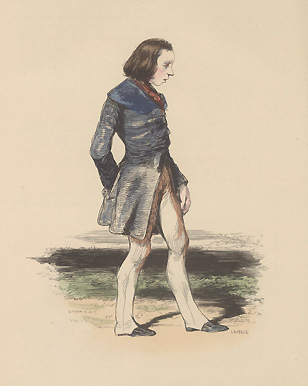
Gavarni, Paul, 1804-1866
“Le poëte : Type”
In : Les Français peints par eux-mêmes,
encyclopédie morale du dix-neuvième siècle. Vol. 2.
Paris: L. Curmer, 1840.
John Hay Library Starred Books Collection
Les Français peints par eux-mêmes is one of the most famous works of “Panoramic Literature.” This term was coined to designate a collective and serial publication describing contemporary customs and social types popular in the 19th century. Well-known French writers (George Sand, Honoré de Balzac, and Victor Hugo among others) contributed chapters to these collective works. The eight volumes of Les Français peints par eux-mêmes present short texts about social types and stereotypes and are illustrated by prints.
[Top]

Carjat, Étienne
[Phototypie de Charles Baudelaire]
In : Les fleurs du mal : MDCCCLVII-MDCCCLXI /
Charles Baudelaire ; édition revue sur les textes
originaux accompagnée de notes et de variantes
et publiée par Ad. van Bever.
Paris : G. Crès, 1922.
Étienne Carjat (1828-1906) was a French photographer and caricaturist known mostly for his photographic portraits of writers and artists. Some of his most famous photographs are portraits of Baudelaire, Zola, Rimbaud and Hugo.
[Top]
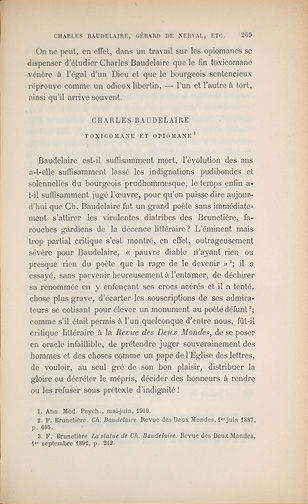
Dupouy, Roger, 1910–
“Charles Baudelaire, toxicomane et opiomane”
In : Les opiomanes : mangeurs, buveurs et fumeurs
d'opium : étude clinique et médico-littéraire /
par le Dr. Roger Dupouy ; préface de M. le Professeur Régis.
Paris : Librairie F. Alcan, 1912
John Hay Library Starred Books Collection
This text offers a clinical study of the representation of drugs in literature, and has a section in response to Baudelaire’s Les Paradis artificiels.
[Top]
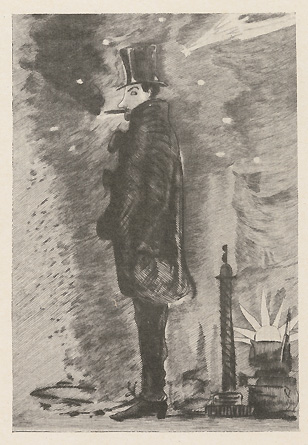
Baudelaire, Charles, 1821-1867
[Samuel Cramer : Frontispiece of La fanfarlo]
In : La fanfarlo ;
avec neuf dessins de Baudelaire, dont un inédit.
Paris : Éditions de La Sirène, 1918.
John Hay Library Starred Books Collection
Samuel Cramer, the main character in the novella La fanfarlo, is represented in this frontispiece by the own hand of the writer. Critics have been unanimous in describing the short story as being autobiographical.
[Top]
![Rochegrosse, Georges, 1859-1938, [Charles Baudelaire] Rochegrosse, Georges, 1859-1938, [Charles Baudelaire]](img/fleursdumal/pari001622_308px.jpg)
Rochegrosse, Georges, 1859-1938
[Charles Baudelaire]
In : Les fleurs du mal / Charles Baudelaire ;
nombreuses illustrations de Georges Rochegrosse
gravées à l’eau-forte et sur bois.
Paris : Librairie des amateurs, A. Ferroud, F. Ferroud,
successeur, 1917.
John Hay Library Starred Books Collection
Georges Rochegrosse, a French historical painter, was awarded the Legion of Honor in 1892.
[Top]
Baudelaire began his career as an art critic in 1845 with the publication of the Salon de 1845, his review of the state-sponsored Salon which was the main art exhibition of the time. Baudelaire developed as an art critic to become a master of the genre, and one of the recurring themes of his texts is his support of Eugène Delacroix. Delacroix was one of the leading French Romantic painters and was not always in favor with the artistic establishment. But in his Salon de 1846, Exposition Universelle de 1855, and Salon de 1859, Baudelaire promoted Delacroix as the most modern and original painter of the time.
Napoléon III intended the Exposition Universelle of 1855 to glorify France, and the over 5,000 paintings and sculptures that were exhibited at the Palais des Beaux-Arts certainly suggested the preeminence of French art. The retrospective exhibit of masterpieces by Delacroix, such as the Barque of Dante (Dante et Virgile aux enfers), Massacre at Chios (Massacres de Scio), and Hamlet and the gravediggers (Hamlet et les fossoyeurs), gave Baudelaire the opportunity to evaluate his historical importance and legacy. For Baudelaire, Delacroix embodies “la partie mélancolique et ardente” of the 19th century; he is without predecessor or successor, but paradoxically is also essential to historical succession.
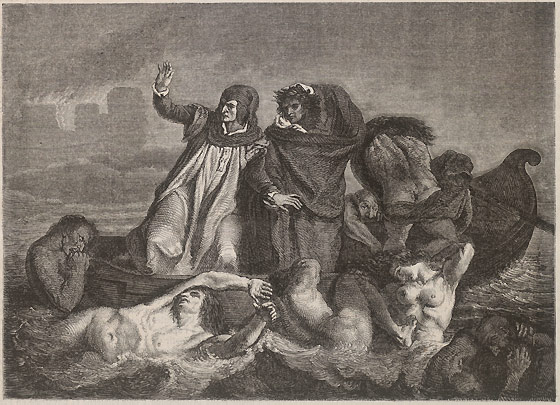
Delacroix, Eugène, 1798-1863
Above: "Dante et Virgile" ("La barque de Dante")
Below: Exposition universelle des beaux-arts: "Le massacre de Scio"
In : L’Illustration, journal universel, 23 juin 1855, no. 643, vol. XXV.
John Hay Library Starred Books Collection
From “Salon de 1846: Eugène Delacroix”
“Ce fut devant cette peinture, [Dante et Virgile] où quelque temps après, devant Les pestiférés de Scio [1] que Gérard lui-même, qui, à ce qu’il semble, était plus homme d’esprit que peintre, s’écria: “Un peintre vient de nous être révélé, mais c’est un homme qui court sur les toits!” — pour courir sur les toits, il faut avoir le pied solide et l’oeil illuminé par la lumière intérieure.”
1. Je mets pestiférés au lieu de massacre, pour expliquer aux critiques étourdis les tons chair si souvent reprochés.
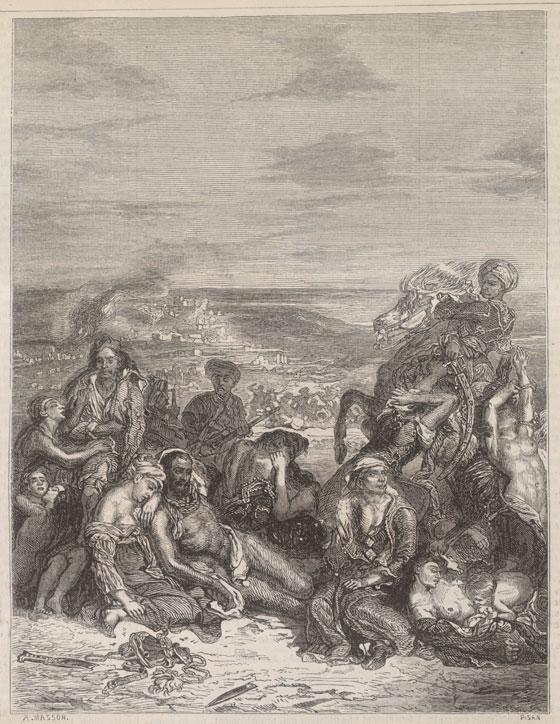
[Top]
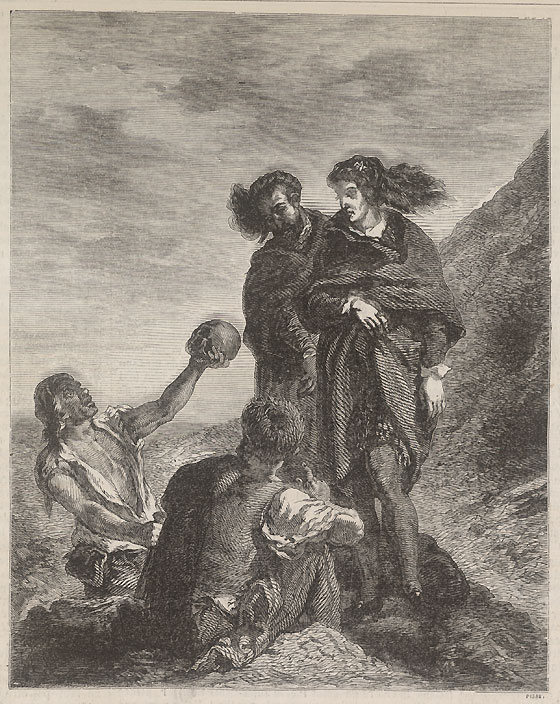
Delacroix, Eugène, 1798-1863
Exposition universelle des beaux-arts: "Hamlet et les fossoyeurs"
In : L’Illustration, journal universel, 23 juin 1855, no. 643, vol. XXV.
John Hay Library Starred Books Collection
“Ce n’est pas là le Hamlet tel que nous l’a fait voir Rouvière, tout récemment encore et avec tant d’éclat, âcre, malheureux et violent, poussant l’inquietude jusqu’à la turbulence. C’est bien la bizarrerie romantique du grand tragédien; mais Delacroix, plus fidèle peut-être, nous a montré un Hamlet tout délicat et pâlot, aux mains blanches et féminines, une nature exquise, mais molle, légèrement indécise, avec un oeil presque atone.”
[Top]
